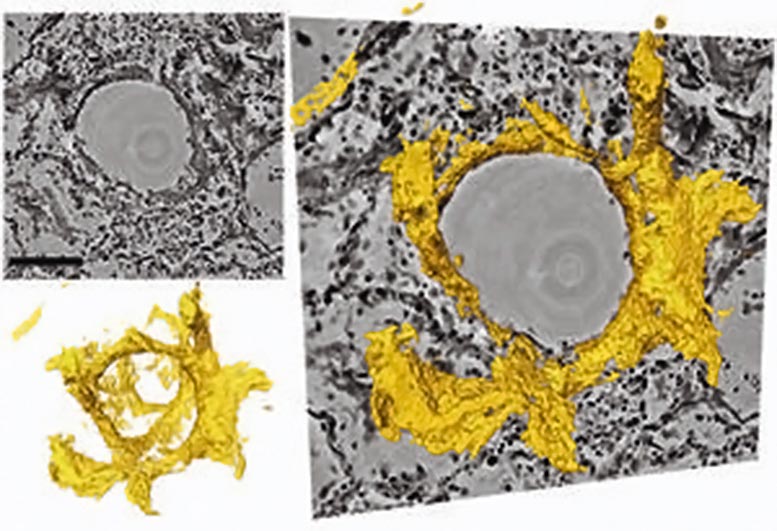

Sections through the three-dimensional reconstruction volume (upper left, gray) around a pulmonary alveolus with hyaline membrane (lower left, yellow). On the right, the images are exaggerated. In the center is the air bubble (alveolus). The electron density is represented by different shades of gray. On the inside of the air bubble is a layer of proteins and remnants of dead cells, the “hyaline membrane”. This deposit, which can be represented for the first time in its three-dimensional structure by the new method, reduces gas exchange and leads to respiratory distress. Credit: T Salditt, M Eckermann
Researchers led by Göttingen University is developing new three-dimensional imaging technology to visualize tissue damage in malignant Covid-19.
Physicists at the University of Göttingen, together with pathologists and lung specialists at the University of Hanover, have developed a three-dimensional imaging technique that enables high-resolution and three-dimensional representation of damaged lung tissue after severe Covid-19. Using a special X-ray microscopy technique, they were able to image changes caused by the coronavirus in the structure of alveoli (the thin air sacs in the lung) and the vasculature. The results of the study were published in the research journal eLife.
In serious Covid-19 disease, the researchers observed significant changes in the vasculature, inflammation, blood clots, and “hyaline membranes”, which are composed of proteins and dead cells deposited on the alveolar walls, making gas exchange difficult as well as impossible. to make. With their new imaging approach, these changes can be visualized for the first time in larger tissue volumes, without cutting or coloring the tissue as in conventional histology. It is particularly suitable for detecting small blood vessels and their branches in three dimensions, locating cells of the immune system that are recruited to the sites of inflammation, and measuring the thickness of the alveolar walls. Due to the three-dimensional reconstruction, the data could also be used to simulate gas exchange.

Professor Tim Salditt. Credit: University of Göttingen
“Zoom tomography can scan large areas of lung tissue embedded in wax, allowing detailed research to find interesting areas around inflammation, blood vessels, or bronchial tubes,” says lead author Professor Tim Salditt of the Institute of X-Ray Physics at the University of Göttingen . Since X-rays penetrate deep into tissue, scientists can understand the relationship between the microscopic tissue structure and the larger functional architecture of an organ. This is important, for example, to visualize the tree from blood vessels to the smallest capillaries.
The authors predicted that this new X-ray technique would be an extension of traditional histology and histopathology, areas of study dating back to the 19th century.th century when optical microscopes had just become available and pathologists were able to discover the microscopic origin of many diseases. Even today, pathologists still follow the same basic steps to prepare and examine tissue: chemical fixation, cutting, staining, and microscopy. However, this traditional approach is not sufficient when three-dimensional images are required or when large volumes need to be screened, digitized or analyzed with computer programs.
Three-dimensional imaging is known from medical computed tomography (CT). However, the resolution and contrast of this conventional technique are not sufficient to detect the tissue structure with cellular or sub-cellular resolution. Therefore, the authors used “phase contrast”, which exploits the different propagation velocities of X-rays in tissue to generate an intensity pattern on the detector. Salditt and his research team at the Institute of X-ray Physics developed special illumination optics and algorithms to reconstruct sharp images of these patterns, an approach they have now adapted for the study of lung tissue affected by severe progression of Covid-19. The Göttingen team was able to record lung tissue at scalable size and resolution, providing both larger overviews and close-up reconstructions. Depending on the setting, their method can even provide structural details under the resolution of conventional light microscopy. To achieve this, the researchers used very powerful X-rays generated at the PETRAIII storage ring of the German Electron SynchrotronDESY) in Hamburg.
As was the case when the modern microscope was invented 150 years ago, significant advances have resulted from collaboration between physicists and medical researchers. The interdisciplinary research team hopes that the new method will support the development of treatment methods, medicines to prevent or reduce severe lung damage in Covid-19, or to promote regeneration and recovery. “It is only when we can clearly see and understand what is really happening that we can develop targeted interventions and drugs,” adds Danny Jonigk (Hannover Medical University), who is leading the medical part of the interdisciplinary study.
Reference: “3d virtual pathohistology of lung tissue COVID-19 patients on the basis of phase contrast X-ray tomography ”by Marina Eckermann, Jasper Frohn, Marius Reichardt, Markus Osterhoff, Michael Sprung, Fabian Westermeier, Alexandar Tzankov, Mark Kühnel, Danny Jonigk and Tim Salditt, 20 August 2020, eLife.
DOI: 10.7554 / eLife.60408
medRxiv